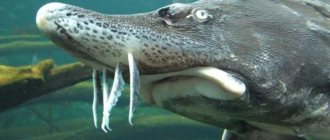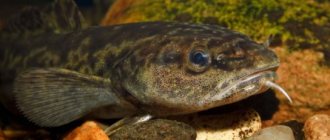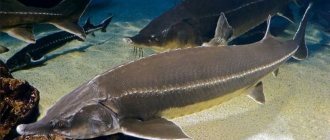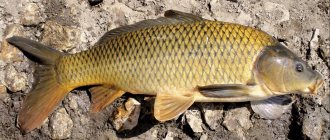A state in which oil is almost everywhere can easily afford to make the life of its citizens secure and as comfortable as possible. The indigenous population here is not only given bank loans without interest and taxes, but also provided with other benefits.
Those who were born in this country will receive lifelong support and assistance from it and do not have to worry about their future.
Kuwait is one of the richest countries in the world / Photo: careerland-center.com
The area of Kuwait is only 18 thousand square kilometers / Photo: geosfera.org
Kuwait is one of the richest countries in the world. The state is very small - 18,000 square kilometers. That is, Kuwait is only seven times larger than Moscow in area. It is located in the southwestern part of Asia.

The currency of Kuwait, the dinar, is the most expensive in the world / Photo: forexdengi.com
It wasn't always like this. Some thirty years ago the state was occupied by Iraq, but today it is absolutely independent and has a very high standard of living. Its currency is the most expensive of all existing ones in the world - one dinar is equivalent to 243 rubles. As for gasoline, you won’t be able to find cheaper anywhere - on average, one liter last year cost 0.3 US dollars.
King fish
Beluga is a long-lived fish. She can live a hundred years. During this time, the largest beluga can grow to a gigantic size of several meters. This species is considered one of the largest marine fish on the planet.
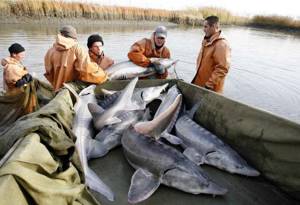
This fish spawns several times in its life. Experts say that beluga eggs are also gigantic, weighing up to half a ton.
To spawn, females go to rivers flowing into the sea, sometimes rising upstream for several kilometers. It is noteworthy that if there is no place suitable for the babies, the fish will not spawn, and the eggs inside will gradually dissolve.
Nutrition
Beluga is a predator fish. It can feed on mollusks, worms, and insects, but its main “dish” is fish. Even beluga fry are predators. Large belugas can even swallow seal pups - they are sometimes found in the stomachs of Caspian representatives of the species. Feeling hungry after spawning, beluga females even grab inedible objects: driftwood, stones.
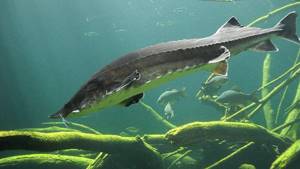
Beluga on the hunt
Such giant creatures can only find enough food in the sea; those subspecies that prefer to live in fresh water do not reach huge sizes.
How to catch the biggest beluga?
Today, industrial fishing of this fish is prohibited. An equally strict veto was imposed on the collection of beluga caviar. But the law does not prohibit sport fishing. Special gear is used for it, which minimally injures the fish.
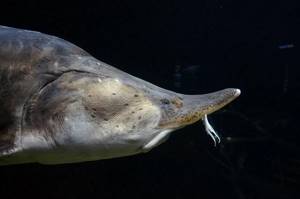
Fishing is one way to establish and document the facts. The largest beluga in the world, caught by an enthusiast in a competition, will certainly be measured, weighed, photographed, and then released. If this did not happen regularly, we would know much less about the life of these amazing fish.
To catch the storm of the seas and rivers, you need to swim 3 kilometers from the sea into the river. Beluga is a voracious predator; fishermen have even found ducks and white whales in its stomach more than once. When choosing bait, you should give preference to raw meat and fish. Professionals know: although the beluga is not aggressive, like, for example, a catfish, it is quite capable of seriously misbehaving. In an attempt to get away from the fisherman, she can even capsize the boat.
Reproduction
Puberty occurs quite late. The male Azov beluga is ready to breed at the age of 12 years, and the female - not earlier than 16-18 years. The Caspian species matures later, so the female becomes sexually mature by the age of 27 and gains weight. Unlike other fish that die after spawning, the Azov beluga can produce offspring repeatedly, but with a certain period of time ranging from 2 to 4 years, thus spawning can occur 8-9 times during its life. On average, a female lays about a million eggs, and in some cases much more, depending on her size and age.
There are 2 races that go to spawn and choose the spring or autumn migration period. Entering the river from January to May, the female lays eggs in the same year, and the autumn race, in order to find a place convenient for spawning and safely occupy it, comes in August and is forced to stay for the winter. Thus, she spawns only the next year after entering the river. Hibernating and covered in mucus, the beluga waits until May or June, after which it lays eggs in places with a rocky bottom and fast currents. Males appear in the spawning grounds earlier than females, and the process of fertilization occurs in almost the same way as in all bony fish - externally. In the future, individuals continue to lead a solitary lifestyle.
The largest representatives: confirmed facts
The largest beluga caught in Russia in 1922 still holds the title. She weighed 1224 kg and was caught in the Caspian Sea. The giant fish was filled with caviar. The photo of the largest beluga is simply amazing. The king fish is comparable in size to ocean monsters: sharks, killer whales, narwhals.
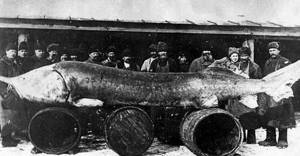
Several other cases of giant-sized beluga sturgeons have been caught. In Kazan there is even a stuffed giant fish, which weighed a ton during its life. The 4.17 m long carcass was donated to the city by Nicholas II himself, and today a stuffed animal made from it is exhibited in the museum. Anyone can admire the huge fish.
There is an exhibit a little more modest than the Kazan one in one of the museums in Astrakhan - the beluga caught in the Volga reached 966 kg. Another curious specimen during life had a length of almost 6 meters and a weight of up to a ton. His story is amazing. This beluga was caught by poachers, the most valuable caviar was gutted, and the carcass was thrown away. But of course, they simply could not help but know what treasure fell into their hands! Fearing arrest for illegal activities, the poachers simply called the museum and told them where they dumped the carcass. It was damaged by careless cutting, but taxidermists managed to make a stuffed animal out of it.
One and a half ton Beluga? -Yes, I was caught like that too. Let's see what fishing was like before the reservoirs
We found a mention in the Ulyanovskaya Pravda newspaper from 1945 that a beluga weighing 760 kg was caught in the Volga near Krasny Yar.

We were surprised. But, as it turned out, this is not the limit. The following is a compilation from various materials, including ours.
According to the most famous photo, widely circulated on the Internet. It was this that laid the foundation for the fish museum located in Tetyushi. There, in 1921, a beluga weighing 960 kilograms was caught. The fish was eaten, but the photograph remained. Nearby is a team of fishermen who caught it.
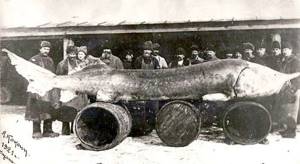
Below is a selection of captured record holders from the website zoomagazin.ru: In 1827, a beluga weighing one and a half tons, that is, 1,500 kilograms, was caught in the lower reaches of the Volga. Just imagine, this weight is comparable to the weight of some whales. Thus, a narwhal whale weighs about 940 kilograms, and a killer whale weighs 3,600 kilograms. That is, this fish weighed as much as half an orca and more than a narwhal! On average, a standard beluga weighs about 19 kilograms (the weight of a fish typical for the Northern Caspian). In the past, the average weight of beluga on the Volga was about 70-80 kg, in the Danube habitat of the Black Sea region - 50-60 kg, in the Sea of Azov the fish weighed 60-80 kg. But in the Don delta, males weighed 75-90 kg, and females - as much as 166 kilograms. Even the average weight already speaks of the enormous size and heaviness of this fish.
However, the average weight of most individuals in the population does not even come close to the record weight of the largest beluga. On May 11, 1922, at the mouth of the Volga, in the Caspian Sea, a beluga weighing 1224 kilograms, that is, 1.2 tons, was caught! At the same time, there were 667 kilograms on the body, 288 kilograms on the head and 146.5 kilograms on the calf.
The weight of the female during the spawning period increases many times. After all, beluga lays millions of eggs! In 1924, a female of the same weight of 1.2 tons was caught on the Biryucha Spit in the Caspian Sea. At the same time, 246 kilograms of weight were in the caviar. The total number of eggs was 7.7 million! The records of giant belugas do not end with the above examples. On May 3, 1926, a 75-year-old female weighing more than one ton was caught at the mouth of the Urals. She carried 190 kg of caviar.

The Beluga, a stuffed animal of which is kept in the National Museum of Tatarstan, weighs about one ton. This fish was caught at the beginning of the 20th century in the lower reaches of the Volga. In the southern part of the Caspian Sea in 1836, a beluga weighing 960 kg was caught.
Over time, the record weight of the largest belugas decreased and no longer exceeded a ton. In 1970, an 800-kilogram beluga was caught on the Volga, which contained 112 kg of caviar. There, in 1989, a fish weighing 966 kg was caught.
And here is a photo of the Ulyanovsk beluga. She was caught in 1933 near Bely Yar - weighing 343 kg.
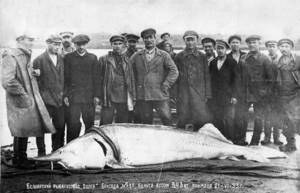
Pikabu: In October 1891, when the wind stole water from the Taganrog Bay of the Sea of Azov, a peasant passing by the exposed shore discovered a beluga in one of the puddles, pulling 20 pounds (327 kg), of which 3 pounds (49 kg) were caviar.
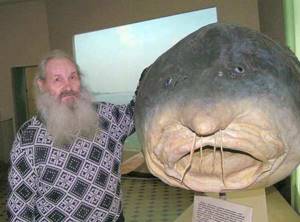
This stuffed animal is in the Astrakhan Museum of Local Lore and is even the subject of the “sad fish” meme.
And alas: Due to hydraulic construction and pollution of reservoirs, its catches, like other sturgeon, have decreased significantly. Currently, stocks of this fish are maintained almost exclusively through artificial breeding in fish hatcheries.
The current state of the species causes serious concern among ichthyologists. The weight of most belugas caught over the last 20-30 years does not exceed 300 kilograms, and the age of these fish is no more than 40-50 years. If in the middle of the 20th century about 25 thousand belugas going to spawn were recorded in the Volga, then at the beginning of the 21st century their number did not exceed 5 thousand.
Quote: In the period from 1961 to 1989, the beluga reached the Volgograd hydroelectric complex along the Volga, where a fish lift was built at the Volzhskaya Hydroelectric Station specifically for migratory fish, which, however, worked unsatisfactorily. As a result, back in Soviet times, in 1989, the fish lift was decommissioned.
Information (more details on Wikipedia): Beluga is the largest sturgeon fish. Sturgeon fish are among the most valuable commercial species. These are unique relict fish that have survived millions of years of evolution and adapted to diverse environmental conditions, and the most unusual of them is the beluga.
If you find an error, please select a piece of text and press Ctrl+Enter.
The language barrier
Sometimes confusion arises for completely unusual reasons. For example, for a very long time the word “beluga” in Russian was also applied to the whale, today known as beluga. Whales, of course, are larger than sturgeon, but this did not prevent fantastic rumors from arising. Eyewitness accounts of the catch of two-ton belugas most likely refer specifically to marine animals. By the way, beluga whales can sing. It was their singing that formed the basis of the phraseological unit “Roar like a beluga.” Sturgeon fish, of course, cannot roar.
And in English, many sturgeon fish, including beluga, are often designated by one word - sturgeon. This also often brings confusion to the question of the largest beluga. Some of the declared contenders for the championship belong to other species of the Sturgeon family.
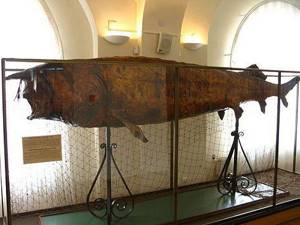
Lifestyle and life cycle
It belongs to the migratory fish species: in the deep sea it is found alone for feeding purposes, while it likes to spawn in schools in fresh, shallow rivers. Finding a sufficient amount of food in the seas, it dives to different depths (depending on the depth level of the organisms). Sturgeon live a long time, on average 40 years, but can live up to 100 years.
Belugas migrating during spawning are divided into two groups. The winter fish (its bright representative lives in the Caspian Sea) swims into large rivers in flocks in the autumn, the spring fish - in the spring. By itself it is a solitary fish.
Loves unpolluted sea spaces closer to the bottom. Warmth is one of the conditions for its habitat in a certain place. In cold seasons, she, having hunted enough, swims away into the hole she finds at the bottom. Covered in a layer of mucus, it goes into hibernation. With the help of such simple actions, the beluga survives the cold.
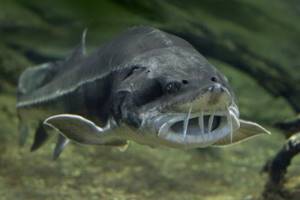
Prospects
The largest beluga is a rarity today. Fortunately, humanity is trying to correct the mistakes of the past. Beluga is listed in the Red Book, the state is fighting poaching. Today beluga is artificially bred in many countries. Several hybrids have been bred in Russia that have shown excellent viability and industrial value. This helps maintain the number of beluga sturgeon in the wild. The positive dynamics give hope that the beautiful king fish will not sink into oblivion in the coming years, but will someday again amaze people with its enormous size.
Description of the species
The Triassic period of the planet’s development is considered to be the beginning of the evolution of sturgeon fish species, which dates back about 210–240 million years. The heyday of the beluga and its relatives occurred in the era of dinosaurs, which reigned on Earth about one hundred to two hundred million years ago. Nevertheless, the appearance of the giant fish has undergone virtually no changes.
What a beluga looks like: its torpedo-shaped body is securely enclosed in a shell of bone plates, and on the sides the bone protrusions form peculiar paths. The face of this fish is unusual; its appearance differs even from its closest relatives. The fused gill membranes form a loose fold below the gill gap. The huge crescent-shaped mouth is bordered by small flattened mustaches with leaf-shaped appendages, providing the hostess with an excellently developed sense of smell. Developed coordination helps the fish navigate in space, successfully complementing its rather poor vision.
The color of an adult beluga is gray-brown on the back and light, almost white, on the belly.

Large and sometimes simply huge sizes, tasty and nutritious meat and valuable caviar have provided the beluga and its numerous relatives (sturgeon, sterlet, stellate sturgeon, kaluga) with the status of commercial fish. This brought the entire family into danger of extinction. Human activity leads to pollution and sometimes to the complete destruction of habitual habitats; hydraulic structures change or block routes to spawning grounds. The combination of these factors puts the beluga on the brink of extinction.
What kind of life does a beluga lead?
![]()
Beluga is an incredibly active creature. This fish periodically migrates over long distances. These huge creatures live mainly in the seas, but during the mating season they go in search of large rivers. In sea waters, fish swim alone, and during migration they gather in large groups. Moreover, spring belugas set off on their journey in the spring, and winter ones - in the fall.
What does beluga eat?
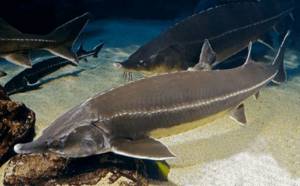
Beluga is a very formidable and dangerous carnivorous creature. It feeds mainly on fish: herring, carp, sterlet, roach, pike perch, and gobies. The diet of this creature also includes mollusks and crustaceans. Sometimes the beluga even hunts its smaller relatives. Beluga cubs initially eat larvae, sea plankton and eggs of other fish. After their first migration, they begin to eat crustaceans and molluscs. As the young grow older, they gradually switch to a more serious diet, that is, they begin to hunt other fish.
Beluga is an albino
Among the sturgeon fish species, there is a unique fish - the albino beluga sturgeon; many private fish farms are ready to give any money just to get such a specimen. It is almost impossible to meet an albino beluga in the wild; the chances are approximately one in a million. This fish is also valued because it produces not black caviar, like other sturgeon breeds, but golden-colored caviar. On the world market, golden albino beluga caviar costs approximately $40,000 per 1 kg. Another feature of the albino beluga, unlike the ordinary beluga, is that individuals are blind, and some specimens have no eyes.
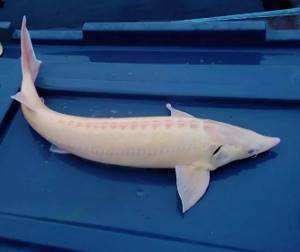
Azov Beluga
The Azov beluga differs from the rest by its wide and short head , wide snout and forehead, and high body. Beluga also grows much faster in the Sea of Azov than in other basins. The main place where this fish lays eggs is the Don River. Migration occurs from March to December. Juveniles feed on fry. Larger individuals feed on gobies and crustaceans. There is even evidence that they can even eat jellyfish and ctenophores. As a result of the reduction in the number of gobies, which they mainly feed on, there was a decrease in the number of this fish.
